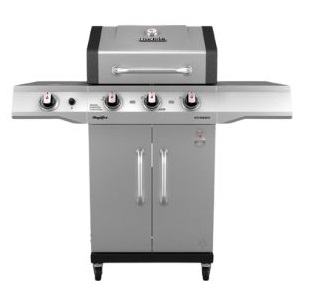
Burners: 3
BTUs: 36,000
This flat iron griddle is powered by 36,000 BTUs below the flat iron top and features three cooking zones to prepare a variety of food at once. This flat iron grill provides plenty of cooking versatility with the ability to cook everything from breakfast to burgers on a single cooktop.
For
- Maintains heat
- Versatile cooking surface
- Easy to move
Against
- Lots of maintenance
- No temperature gauge

Burners: 3
BTUs: 27,000
The grilling surface has enough area to fit up to 14 burgers on its 375 square inch cooking area. That’s plenty of the cooking surface for not only burgers, but a variety of meats on those summer BBQ days. It’s Amplifire cooking system also helps prevent flare ups and distribute heat for a even grilling experience.
For
- Great for cooking meats
- Side burner for pots and pans
- Cabinet to hold propane
Against
- Clunky to move around
When it comes to outdoor cooking, there is one all-encompassing term you’ll hear: Grill. But grills are not griddles and vice versa. For instance, the Char Griller 3 Burner Flat Iron Gas Griddle and the Char-Broil 3 Burner Gas Grill are two outdoor cooking options that are completely unique in their own rights. Open the hood and it’s quite apparent we’re talking about two different beasts here.
So, griddle vs. grill, what’s the big difference? A griddle is becoming a popular option for outdoor cooking aficionados simply for its versatility. Think of a griddle as a giant dutch oven, but flat. The flat iron is also treated for and cleaned as such, but we’ll touch on that in later sections. Flames do not directly touch the food on a flat iron griddle like compared to a grill. But the flat surface provides a ton of cooking versatility as you can cook everything from eggs and vegetables to meats on a griddle.
On the other hand, when you toss meat on your best gas grill, you are exposing your food to open flame. Not only does flame touch the food, it also heats up the grates leaving the classic grill sear marks on your food that are oh so desired. Either gas grill vs charcoal grill are great for cooking meat, but food like vegetables often need extra preparation to be cooked on a grill surface—nothing’s worse than when a vegetable rolls through the grates to meet its demise at the bottom of the grill.
If you’re wondering what’s the best option for cooking outdoors, keep reading as we compare grills and griddles across various key aspects: design, performance, safety and maintenance, and price, to help you determine which suits your needs best.
Grill vs Griddle: Design
There are many differences between the two styles of outdoor cooking machines, but perhaps the biggest is within the design. A griddle features a iron flat top—no grates and no direct exposure to flame. As mentioned above, the surface is essentially a flat dutch oven surface. What’s especially nice about the flat iron surface is that it maintains heat on the surface even after you toss food on there. This makes for a consistent cooking experience without having to adjust cooking times because of a rapidly cooling surface. It also allows for consistent cooking temperatures across the entire cooking area, minimizing hot spots (areas of the surface that are hotter and cook faster than others).
In the bottom left hand corner of the griddle is a little hole only a few inches long and side that serves as the chute for grease and ash. Since ash can’t drop through the grates like on a grill, for cleaning (more on maintenance later), you push everything towards the chute where all the debris and grease is captured in a grease cup underneath the grill.
In contrast, a gas grill boasts a more traditional grill design with porcelain-coated iron cooking grates. Grates allow for direct exposure to high heat flames, making it a great option for searing meats and providing that flavor that many associate with outdoor grilling.
Grills often require a familiarity with the specific model that is being used. Why? Because temperature can vary significantly between different parts of the grill, and from grill to grill. A great outdoor cook knows their grill through and through, where the hot spots are, and where they can place food on the surface to cook slower or quicker.
Flat iron griddles, like the Char Griller, also don’t have a temperature gauge, unlike most gas grills that have a built-in thermometer to let you know how hot the inside of the grill is getting. This can make it a bit more difficult to understand how hot or cold the surface of your griddle is. Griddles, like the Char Griller, also don’t have a cooling rack, like the Char-Broil grill. When food is done, you must remove it from the griddle surface or it will continue to cook. A grill affords you the luxury of keeping a food warm, yet, not exposed to direct heat with a cooling rack that rests above the grilling surface.

Grill vs Griddle: Performance
The versatility of a flat iron griddle is one of its major strengths. “Griddles are best for foods that need to be sauteed in oil or butter,” said Sucher. He continued, “Foods can sit in the oil, butter, or their own juice and absorb a lot of flavor that way with a Griddle.”
A major game changer is that flat iron griddles can be used for breakfast foods like pancakes and omelets making it an all-times-of-the-day cooking tool. Beyond breakfast foods a flat iron grill is good for making sandwiches, quesadillas, and even pizza.
If a smoky flavor profile isn’t your favorite, that’s another reason to cook on a griddle. Cooking on a flat iron griddle does not impart the same smoky flavor that is typical for tossing food on a gas grill. Instead you allow food to cook in its own juices, which can create great browning and caramelization and provide foods a deep and complex flavoring.
While traditional grills are somewhat less versatile than griddles in terms of the variety of foods that can be cooked (don’t try and cook an egg on a grill, you’ll regret it), gas grills are exceptional at the high-heat, quick-cooking of meats like steaks, burgers, chicken, and ribs. That’s not to say that you can only cook meat on a grill. Quite the contrary. Grills can be adapted for cooking other types of food and methods like cooking foods with indirect heat. Cooking foods with other methods simply require a few more steps in the process, like wrapping the vegetables in tin foil so they can cook more slowly and cook in the oil or marinate that you choose.
When it comes to tastes and flavor profiles, the smoky flavor is foundational of grilled foods. The direct contact with the open flame also creates char and grill marks, adding to the flavor and texture of grilled foods (grilled pineapple… is there anything better?)
Dripping fats and juices from meats in particular fall into the flames and create more smoke, which fills up the grill and can infuse the meat with smoky flavor. Especially fatty foods like bratwursts can create a lot of drippings and smoke.

Collin Sucher has been in the food industry essentially his entire professional career. He worked at US Foods as everything from a Fresh Food Specialist to a Restaurant Consultant. He spent another 13 years of his impressive food-based career as a manager of a butcher shop in Salt Lake City, Utah. He and his brother have competed in cooking and grilling competitions across Utah.
Grill Vs Griddle: Care and Maintenance
Griddles require more maintenance after every use. After each use, the griddle should be cleaned with a scraper to remove food residues. For partially hard to remove residue, you’ll want to use water to try to break up the residue. If that doesn’t work, you can use salt to scrub the reminisce off. Don’t use soap and water, as that will ruin the cooking surface. After the griddle is free of leftover food particles, it also needs to be coated with oil (like vegetable oil) to season and protect the flat iron surface. “That’s seasoning the surface. It makes your griddle last over the years. You want to season it (oil) it when it’s warm—not crazy hot—after cleanup. I personally like to use canola oil,” said Sucher. You should also remove and empty the grease trap after easy use. That will make it easier in the long run to ensure your grease trap doesn’t get smelly and gross.
On the other hand, gas grill grates can be quite easy to maintain before and after every cook. You can simply heat up the grill and take a wire brush and scrap any remaining particles from the grates, the combination of the brush and high heat both burns off and cleans the grates. Of course, all of that burned off food and ash will begin to accumulate on the bottom of the grill. You’ll want to give your grill a nice deep clean at the end of every grilling season. “I’ve had my grill and smoker forever. It’s important to deep clean it at least once a year. That’ll keep your cooking tools [grills] operational for a long time,” said Sucher.
You’ll want to use your grill scraper, some gloves, a sponge and a bucket of warm soapy water for the job. Remove the grates and any pans and allow them to soak in the soapy water. Use the scraper to remove any hard accumulations on the bottom of the grill. Remove any additional ash and push it all into the grease pan, then throw it away. You’ll want to wipe down the bottom surface to ensure you removed all ash and residue. Then you can scrub off your grates, ensure everything is dry and put your grill back together.
TDLR: Cleaning after every cookout is more labor intensive with a griddle, but the yearly big clean for a grill does take a lot of work, but once a year isn’t bad.

Grill vs Griddle: Price
Pricing will vary on both a grill and griddle depending on the brand, how large the cooking surface is, power and how many burners you need. For this comparison, two similarly fashioned cooking machines (both have three burners), the Char Griller 3 Burner Flat Iron griddle has an RRP of $299.00, while the Char-Broil 3-Burner Gas Grill is priced at $499.99, we see that the price of a gas grill is more expensive. But you do get extras like a side burner and a cooling rack.
Grill vs Griddle: Verdict
Both have their place in the outdoor cooking world. What we like about griddles is the ability to cook a wide variety of food, including breakfast foods, without any additional equipment or techniques. You can cook an egg, bacon, burger and your vegetable sides all on the same surface.
But if you yearn for the perfectly seared and charred piece of chicken or steak, a grill is the prime choice. Ultimately, it depends on how often you cook, and what you cook. If you find yourself wanting to cook a variety of food, everything from breakfast to veggies, a griddle is a smart choice on versatility and price alone. If you’re a meat lover through and through, it’s hard to beat a classic grill. But both are so different and unique, we recommend having both at your disposal.
If reading this has inspired you to buy a griddle or grill, head to our grills deals hub where we round-up all the latest offers from some of your favorite stores.
